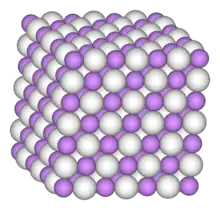Digallane
Digallane (systematically named digallane(6) and di-μ-hydrido-bis(dihydridogallium)) is an inorganic compound with the chemical formula GaH
2(H)
2GaH
2 (also written [{GaH
2(μ-H)}
2] or [Ga
2H
6]). It is the dimer of the monomeric compound gallane. The eventual preparation of the pure compound, reported in 1989,[1][2]
was hailed as a "tour de force."[3] Digallane had been reported as early as 1941 by Wiberg;[4] however, this claim could not be verified by later work by Greenwood and others.[5]
 | |||
| |||
| Names | |||
|---|---|---|---|
| IUPAC name
digallane(6) | |||
| Other names
Di-μ-hydrido-tetrahydridodigallium Gallane dimer | |||
| Identifiers | |||
3D model (JSmol) |
|||
| |||
| |||
| Properties | |||
| Ga2H6 | |||
| Molar mass | 145.494 g/mol | ||
| Boiling point | -50°C (sublimes) | ||
Except where otherwise noted, data are given for materials in their standard state (at 25 °C [77 °F], 100 kPa). | |||
| Infobox references | |||
Preparation
A two-stage approach proved to be the key to successful synthesis of pure digallane. Firstly the dimeric monochlorogallane, (H2GaCl)2 (containing bridging chlorine atoms and thus formulated as (H2Ga(μ-Cl))2) was prepared via the hydrogenation of gallium trichloride, GaCl3, with Me3SiH. This step was followed by a further reduction with LiGaH4, solvent free, at −23 °C, to produce digallane, Ga2H6 in low yield.
- Ga2Cl6 + 4 Me3SiH → (H2GaCl)2 + 4 Me3SiCl
- 1/2 (H2GaCl)2 + LiGaH4 → Ga2H6 + LiCl
Digallane is volatile and condenses at −50 °C into a white solid.
Structure and bonding
Electron diffraction measurements of the vapour at 255 K established that digallane is structurally similar to diborane with 2 bridging hydrogen atoms[2] (so-called three-center two-electron bonds). The terminal Ga—H bond length is 152 pm, the Ga—H bridging is 171 pm and the Ga—H—Ga angle is 98°. The Ga—Ga distance is 258 pm. The 1H NMR spectrum of a solution of digallane in toluene shows two peaks attributable to terminal and bridging hydrogen atoms.[2]
In the solid state, digallane appears to adopt a polymeric or oligomeric structure. The vibrational spectrum is consistent with tetramer (i.e. (GaH3)4).[2] The vibrational data indicate the presence of terminal hydride ligands. In contrast, the hydrogen atoms are all bridging in α-alane, a high-melting, relatively stable polymeric form of aluminium hydride wherein the aluminium centers are 6-coordinated. Digallane decomposes at ambient temperatures:
- Ga2H6 → 2 Ga + 3 H2
References
- Anthony J. Downs; Michael J. Goode; Colin R. Pulham (1989). "Gallane at last!". Journal of the American Chemical Society. 111 (5): 1936–1937. doi:10.1021/ja00187a090.
- Pulham C.R.; Downs A.J.; Goode M.J; Rankin D.W.H. Roberson H.E. (1991). "Gallane: Synthesis, Physical and Chemical Properties, and Structure of the Gaseous Molecule Ga2H6 As Determined by Electron Diffraction". Journal of the American Chemical Society. 113 (14): 5149–5162. doi:10.1021/ja00014a003.
- N.N. Greenwood (2001). "Main group element chemistry at the millennium". J. Chem. Soc., Dalton Trans. (14): 2055–2066. doi:10.1039/b103917m.
- Wiberg E.; Johannsen T. (1941). "Über einen flüchtigen Galliumwasserstoff der Formel Ga2H6 und sein Tetramethylderivat". Naturwissenschaften. 29 (21): 320. Bibcode:1941NW.....29..320W. doi:10.1007/BF01479551. S2CID 44840674.
- Shriver, D. F.; Parry, R. W.; Greenwood, N. N.; Storr, A; Wallbridge, M. G. H. (1963). "Some Observations Relative to Digallane". Inorg. Chem. 2 (4): 867–868. doi:10.1021/ic50008a053.








